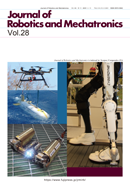28 巻, 4 号
選択された号の論文の18件中1~18を表示しています
- |<
- <
- 1
- >
- >|
Special Issue on Real World Robot Challenge in Tsukuba - Autonomous Technology for Coexistence with Human Beings -
-
原稿種別: Editorial
2016 年28 巻4 号 p. 431
発行日: 2016/08/20
公開日: 2019/07/01
PDF形式でダウンロード (185K) -
原稿種別: Paper
2016 年28 巻4 号 p. 432-440
発行日: 2016/08/20
公開日: 2019/07/01
PDF形式でダウンロード (887K) -
原稿種別: Paper
2016 年28 巻4 号 p. 441-450
発行日: 2016/08/20
公開日: 2019/07/01
PDF形式でダウンロード (2736K) -
原稿種別: Paper
2016 年28 巻4 号 p. 451-460
発行日: 2016/08/20
公開日: 2019/07/01
PDF形式でダウンロード (3818K) -
原稿種別: Paper
2016 年28 巻4 号 p. 461-469
発行日: 2016/08/20
公開日: 2019/07/01
PDF形式でダウンロード (2337K) -
原稿種別: Paper
2016 年28 巻4 号 p. 470-478
発行日: 2016/08/20
公開日: 2019/07/01
PDF形式でダウンロード (1716K) -
原稿種別: Paper
2016 年28 巻4 号 p. 479-490
発行日: 2016/08/20
公開日: 2019/07/01
PDF形式でダウンロード (4601K) -
原稿種別: Paper
2016 年28 巻4 号 p. 491-499
発行日: 2016/08/20
公開日: 2019/07/01
PDF形式でダウンロード (1820K) -
原稿種別: Paper
2016 年28 巻4 号 p. 500-507
発行日: 2016/08/20
公開日: 2019/07/01
PDF形式でダウンロード (1636K)
Regular papers
-
原稿種別: Paper
2016 年28 巻4 号 p. 509-522
発行日: 2016/08/20
公開日: 2019/07/01
PDF形式でダウンロード (3650K) -
原稿種別: Paper
2016 年28 巻4 号 p. 523-532
発行日: 2016/08/20
公開日: 2019/07/01
PDF形式でダウンロード (3257K) -
原稿種別: Paper
2016 年28 巻4 号 p. 533-542
発行日: 2016/08/20
公開日: 2019/07/01
PDF形式でダウンロード (984K) -
原稿種別: Paper
2016 年28 巻4 号 p. 543-558
発行日: 2016/08/20
公開日: 2019/07/01
PDF形式でダウンロード (4684K) -
原稿種別: Paper
2016 年28 巻4 号 p. 559-567
発行日: 2016/08/20
公開日: 2019/07/01
PDF形式でダウンロード (2879K) -
原稿種別: Paper
2016 年28 巻4 号 p. 568-578
発行日: 2016/08/20
公開日: 2019/07/01
PDF形式でダウンロード (695K) -
原稿種別: Paper
2016 年28 巻4 号 p. 579-590
発行日: 2016/08/20
公開日: 2019/07/01
PDF形式でダウンロード (673K) -
原稿種別: Paper
2016 年28 巻4 号 p. 591-599
発行日: 2016/08/20
公開日: 2019/07/01
PDF形式でダウンロード (2880K) -
原稿種別: Development Report
2016 年28 巻4 号 p. 600-608
発行日: 2016/08/20
公開日: 2019/07/01
PDF形式でダウンロード (1764K)
- |<
- <
- 1
- >
- >|
